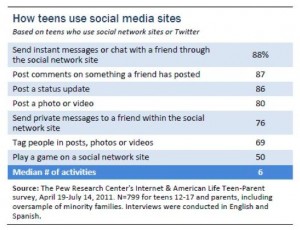Social media spaces are positive spaces for the most part, Amanda Lenhart of the Pew Internet Project reported at the annual Family Online Safety Institute conference today. “People in social network sites are generally kind,” she told the audience as she shared the findings of a Pew report released today, adding that the vast majority of teen social networkers said that a friendship had been strengthened or they felt good about themselves as a result of online social networking.
I found it interesting that, though many adults are concerned about negativity in teen social networking, based on their own experience in social sites, 85% of adult social networkers feel people are mostly kind in them, compared with 69% of teen social networkers. Of course they’re referencing their own experience, but I suggest that adults compare that – or even teens’ lower number – to what they’re hearing in the news about some sort of epidemic of cyberbullying!
As if punctuating the Pew findings, later in the conference, keynote speaker Paul Howard-Jones of Bristol University’s Graduate School of Education, said, “Social network sites generally stimulate teenage social connectedness and psychosocial well-being” and “cyberbullying and abuse appear linked to issues beyond social network sites.”
Low online bullying numbers
In the past year, 8% of US 12-to-17-year-olds have been bullied online and 9% via text messaging, Pew found. In-person bullying is still far more common, but even that has gone down in recent years, both Pew and the Crimes Against Children Research Center at the University of New Hampshire have reported.
When asked if they’d experienced online meanness or cruelty themselves, 15% of 12-to-17-year-olds said yes and 85% said no (0% said they didn’t know). And asked if they’d witnessed mean or cruel behavior, 12% of teens said frequently, 29% said sometimes, 47% only once in a while, 11% said never, and 1% said they didn’t know. As for what had been done about this online mean or cruel behavior by others, 55% observed that people just ignore what’s going on. (Amanda told her audience that in some cases “it’s possible that ignoring what’s going on is an appropriate response, some parents teach their children not to get involved, and the closer a person is to the person being harassed, the more likely s/he is to step in). Pew also found, though, that 27% of teens said they’d defend the targeted person, 20% tell the aggressor to stop, and 19% said they’d seen others just join in the harassment.
‘Parents matter’
Amanda also told us that “these slides should have the title “Parents Matter,” because when Pew asked teens, “Who has been the biggest influence on what you think is appropriate or inappropriate when you are using a cell phone or going online?”, 58% of respondents said their parents, followed by 18% saying their friends have. However, influence and advice are two different things, and Pew also found that, when asked who they turn to for advice after witnessing online cruelty, 53% said a friend or peer and 36% said a parent, followed by a sibling or cousin (5%). And “girls are more likely than boys to receive advice from people other than parents,” the study found.
Pew covered so much ground with this study – including teen privacy practices, sexting, more on parenting, and age, ethnic, and income breakdowns – that I urge you to check out the report. But some general social networking findings show that teen use of social media has increased 25% since 2006 to 80% of US teens overall, with 93% of those social networkers using Facebook. Twitter use by teens has doubled in just two years.
Not much on digital citizenship
The subhead of the Pew Report is “How American Teens Navigate the New World of Digital Citizenship,” but the only aspect of digital citizenship that’s covered at all in it is the part about norms of behavior – what many people refer to as “good citizenship” and sometimes “Netiquette.” Certainly that’s not the whole of what’s emerging from scholarship on the subject around the world.

The elements of digital citizenship that have emerged so far (as I detailed here) also include participation (or digitally supported civic engagement); rights & responsibilities; a sense of belonging or membership; and media, digital, and social literacy. Looking into teens’ views on those would be a huge study, but I look forward to seeing more on their experiences with them.
Related links
- “Online bullying: Still way less common than in real life” from my ConnectSafely.org co-director Larry Magid at CNET
- “Teen study: Social media is positive experience” at NPR
- “Mean teens online: Most ignore them or defend victim – study” at MSNBC
- “Social media, teens, parents and whether to ‘friend’” in a Washington Post blog
- “How teens treat each other on Facebook: New stats fro Pew” at Slate

[…] Wonderful analysis on social media and its impact on students. Teens’ social media experiences largely positive: Study Via […]